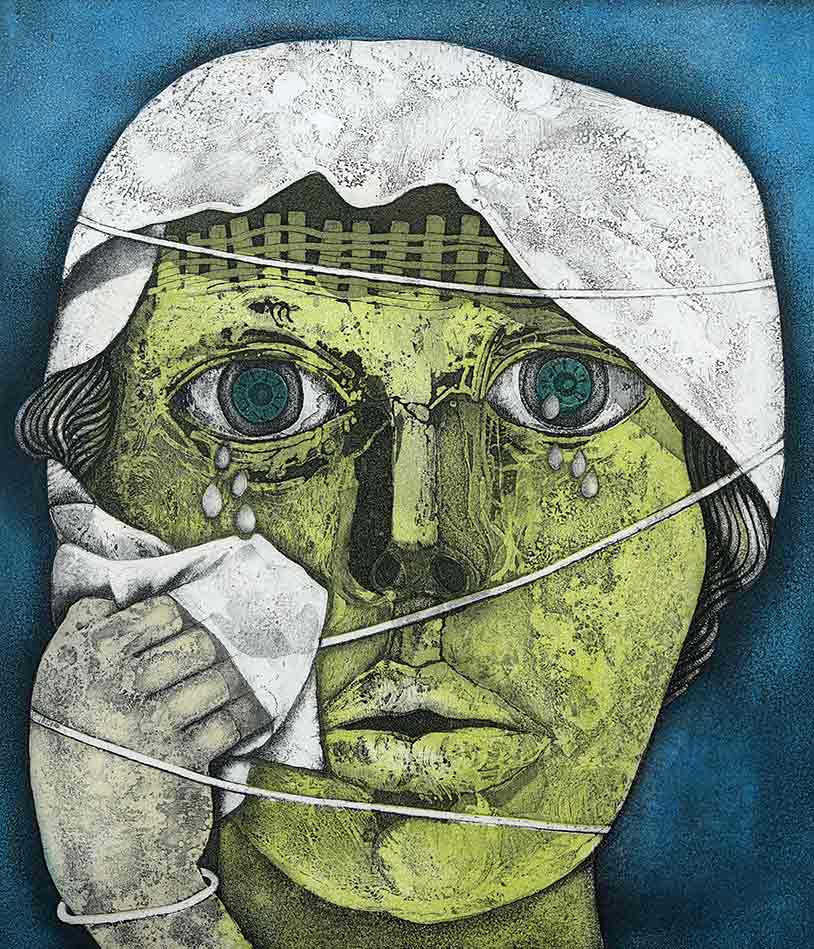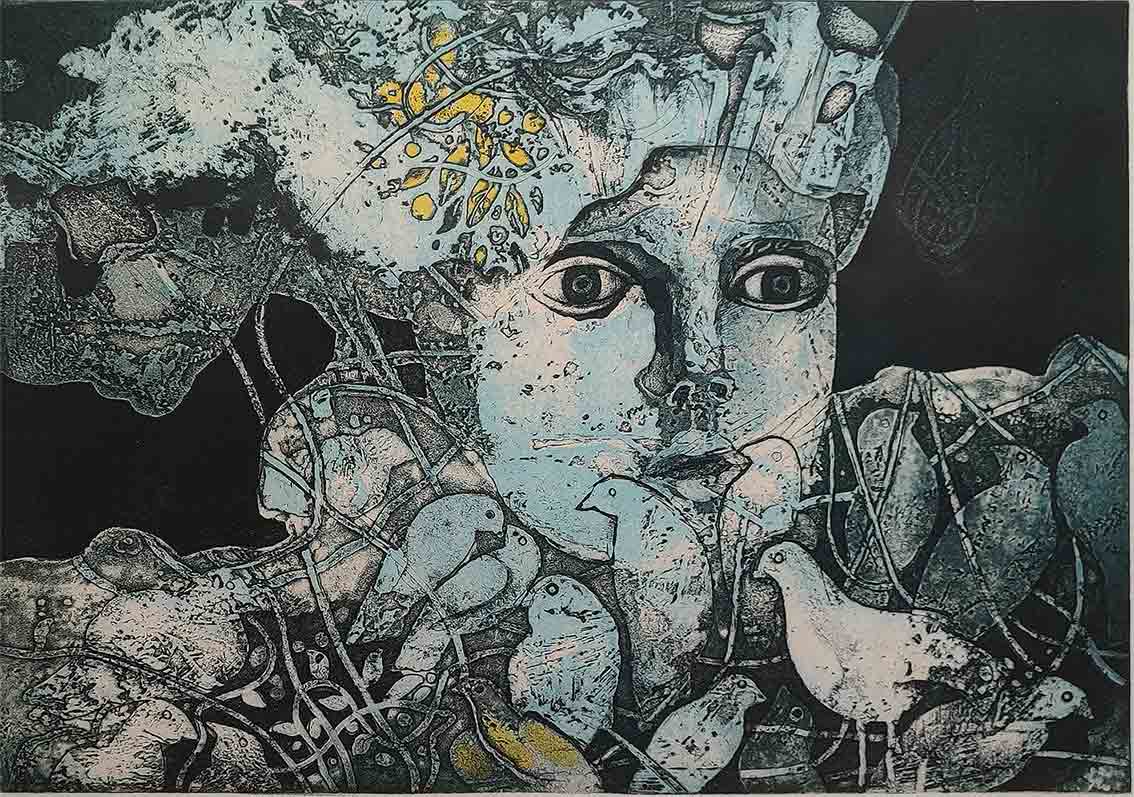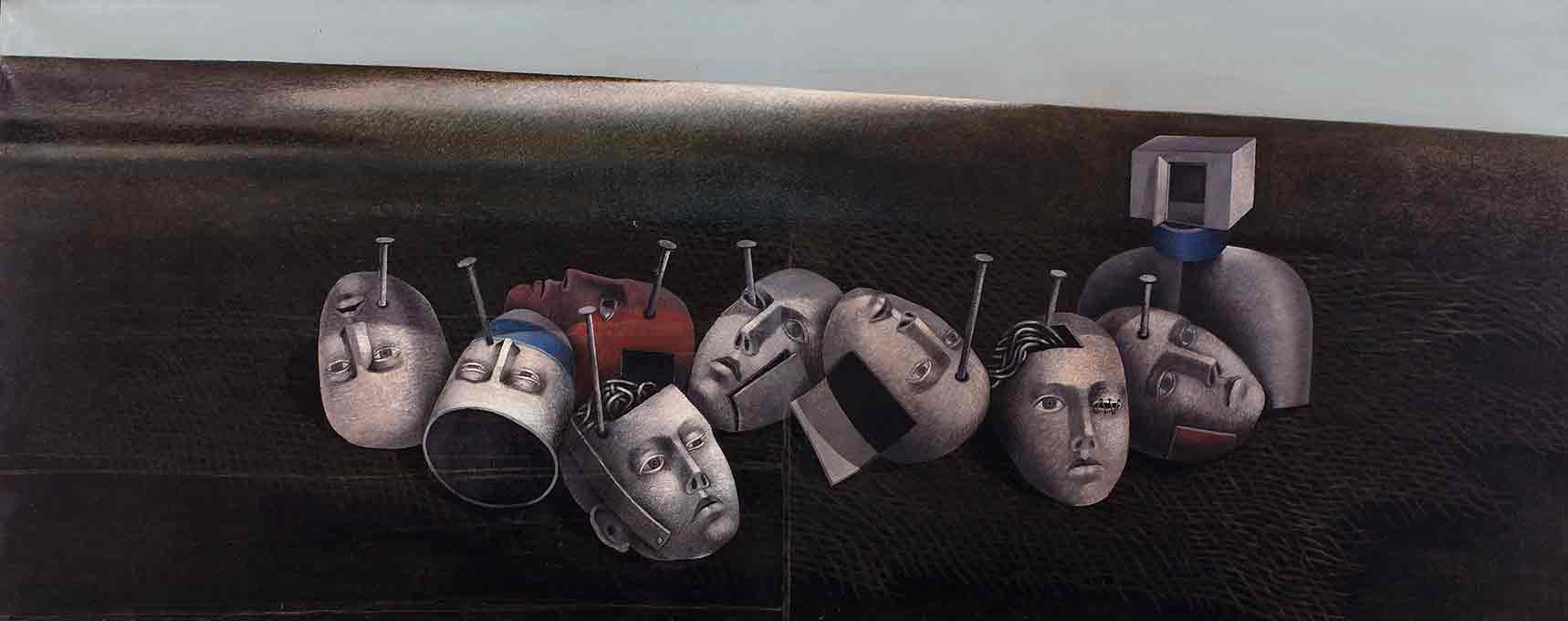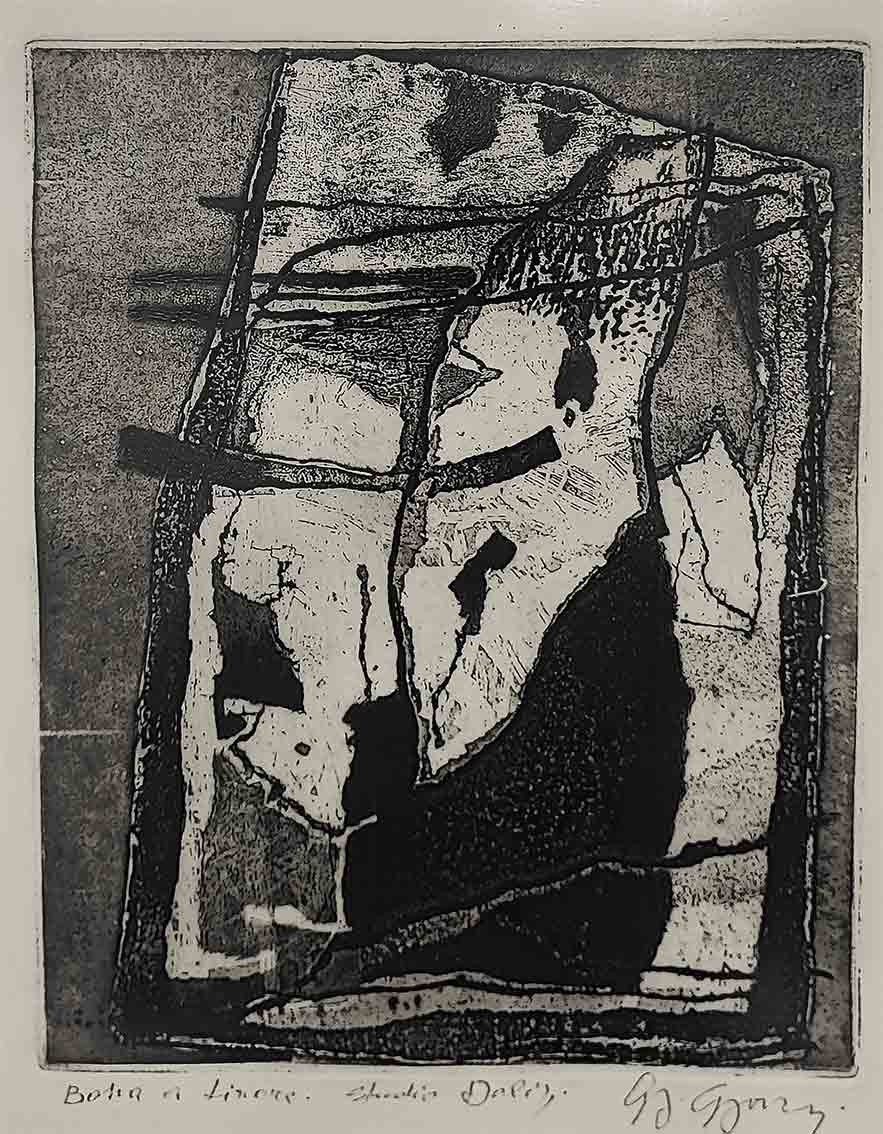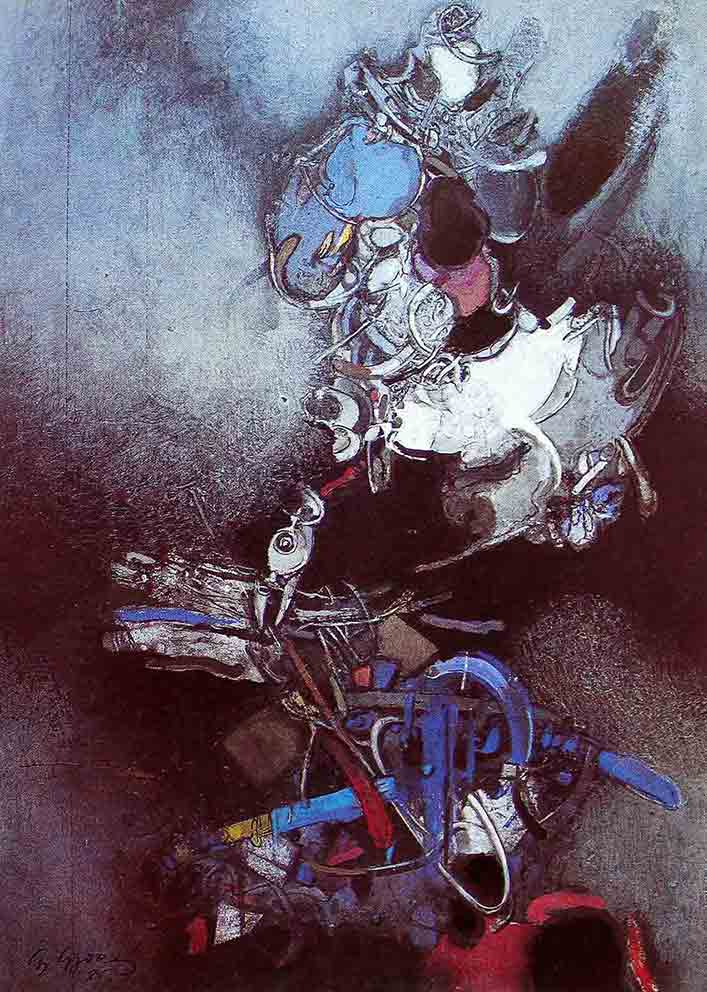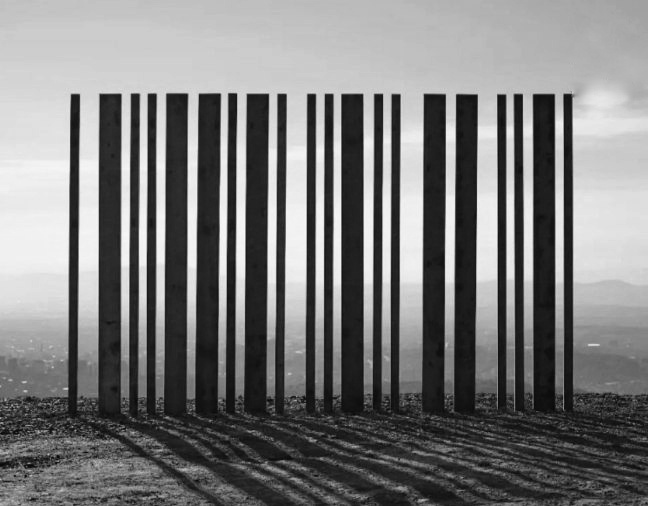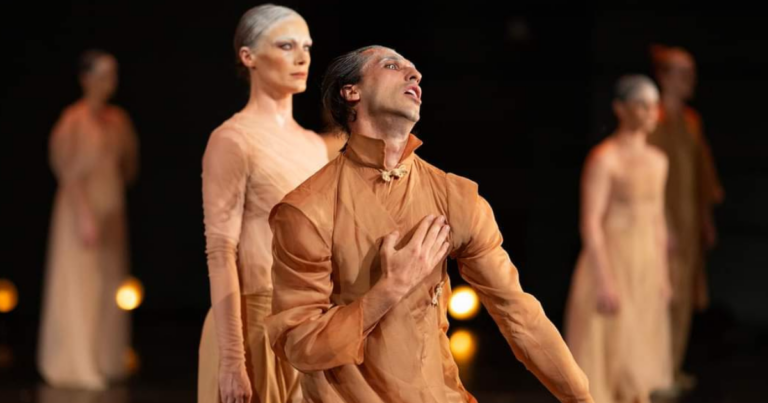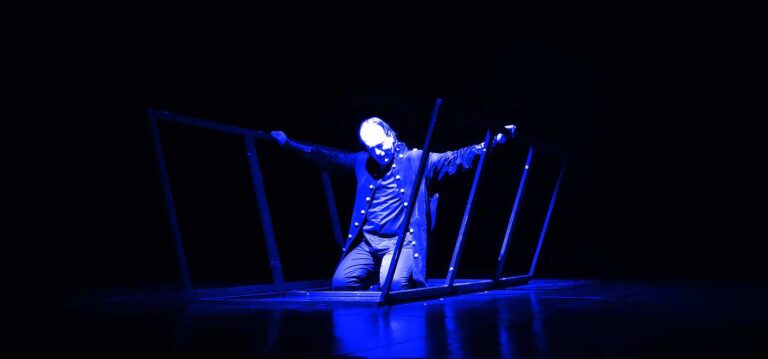Neo Metaphysical Diary
Milot Gusia
Overview of the artistic oeuvre of Gjelosh Gjokaj
The path of artistic development for many artists is determined by their early life experiences, especially their childhood. Childhood experiences and childhood memories influence the artist's expression in several ways, among others their artistic subject and their artistic style.
The artist Gjelosh Gjokaj (born in 1933) embarked on his artistic journey from his small native village, Milesh in today’s Montenegro. Although very small, Mileshi had a very rich and unique cultural and ethnographic heritage. Being part of larger region of Malesia, village Mileshi stands out for its rare beauty and unique landscapes that have inspired many artists and writers.
The mountainous area of Mileshi, is a rich region in rare endemic plants, and also many relics that were part of the artist's childhood. Unique village houses, huts and cottages surrounded by numerous plantations decorated the landscape of the Malesia region.
The region was also distinguished by unique mountain reliefs composed of limestone and dolomites, rich in mountain peaks as well as glaciers and icy valleys. This was the environment where the artist grew up and initially found his inspiration. He was especially interested in stone as the main component of his mountainous surrounding.
"The stone has always been a symbol for me. I have been dealing with experiences of stones for a long time. I studied their forms. When I managed to master the technique of experiencing the stone, and replicating it, I found myself, gained independence and began to assert myself with my art. Let's face it, this is a process that still continues today in my art..." (Gj. Gjokaj, “Përkimet dhe Bukuria e Mallkuar” – A. Podrimja).
This was the beginning of the artist's preoccupation with the everyday materials and vernacular world. Experiences gathered from cognitive and psychological processes of his childhood were a large body of creative resource and emotional expression for the artist. Therefore, his artistic creativity can be said to be a sublimation of his personal experiences.
Each generation of artists is deeply rooted in its cultural environment and upbringing with a keen sense of time.
Childhood memories will inevitably find their way into the artists’ works, whether intentionally or unconsciously.
However, childhood memories are a pool of "creative" inspiration under certain circumstances and not merely “tools for reproduction”. Even if multiple artists encountered an identical life experiences, their artistic expressions would be completely dissimilar.
Gjokaj expressed his initial preoccupation in art through a kind of synthetic symbolism. In this period, in artists’ works are emphasized his interests in local folklore and ethnography, which were expressed through the art of intaglio printmaking with distinguished rough textures.
Even though artist used his folklore as form of expression, he never misused folklore in his art. "We have a very rich folklore, but we need to know how to use it, not to trivialize it" Gjelosh Gjokaj (Donjeta Abazi, 2000).
His studies at the Academy of Visual Arts in the printmaking department under Professor Boshko Karanović had a great impact on the further development of his talent.
He studied printmaking, where he managed to develop his own unique language of artistic expression showing a deeper understanding of intaglio techniques, but also of lines, shapes and spatial relationships. His high passion for aquatint art led him to explore the world of metaphysical figuration.
After his graduation in 1963, heads and other figurative elements begin to appear in his art, which are now materialized through the texture of stone. In this period, the artist begins to crystallize his art into a more complex philosophy with distinguished elements of avant-garde art.
During the period of 1960s, in Gjokaj's oeuvre, the influence of Neo Objective art begins to be noticed, which also started to take its roots in the regional art scene as a reaction to the legacy of modernism.
This trend with a tendency to revive figuration was also present in European art of that time.
In this new art, Gjokaj's paintings became a form of critical narrative directed by the realities of contemporary culture. It was a kind of dialogue with society through irony, allusion and the grotesque.
The influence of Max Beckman, Otto Dix, and George Grosz is evident. The artist begins to juxtapose true stories of his childhood with dreams, myths, and folk fables thus creating an open visual narratives.
In the first figurative pieces, the artist shows similarities in approach with Beckman, who also opposed abstraction and maintained his desire to "keep the magic of reality and transfer this reality to painting."
The artist begins layering figures with signs as well as colors with rich shadows, which enabled him to successfully translate his inspirations into amazing figurative paintings.
Neo-objectivism also enabled him to express through art his political and social manifesto. He started to engage in visually displaying his preoccupation with the Second World War and the human destruction, but also of the political situation in post-war Yugoslavia.
It is interesting to note that art in the former Yugoslavia after the 1950s began to show symbolic signs of breaking away from the ideological themes of socialist realism, with groups like “Zadar” (1947) etc.
The exhibitions of artists such as Antun Motika, Ivan Mestrovic, Miljenko Stančić, Miroslav Šutej and Janez Bernik after the 1950s marked an initiative of modernization and the spread of artistic internationalization in the former Yugoslavia.
The presence of Art Informel or informalism in former Yugoslavia, shifted even further the art of the region from socialist realism but also from post war modernism.
All this changing art environment enabled emerging artists such as Gjelosh Gjokaj to gain a power of artistic expression as well as to use his art for expressing his political opinions.
The rural landscapes of his native villages of the region Malësia were expressed through powerful figurative associations. They are especially present in the artist’s color palette. Gjokaj was deliberately restrained in the use of colors. He wanted to remain faithful to the colors of his childhood, the embers in the chimneys of the houses, nuances of corn and dried meat as well as shades of ash that dominated the furniture’s of the country houses.
"I used to be a fan of colors, but I have seen my painting reduced by this element, because excessive colors does a lot of damage to the painting. Painting with three or four colors, as a graphics, looks much more pleasing".
"Blue and gray colors dominate my paintings. The shades of dust were born from rural environments: ash, smoke and charcoal. Whereas, the shades of blue are of the river that I experienced in my childhood hometown".
The influence of Metaphysical art of De Chirico as well as of surrealists like Rene Magritte, are evident in Gjokaj's later works. Surrealist elements are expressed through the overlay of unusual imagery while Metaphysical elements are expressed in transcendent sceneries of figurative style.
But, contrary to De Chirico (who used classical architecture), Gjokaj started to make use of traditional local architecture in order to create a desolate and cold environments with the use of pronounced shadows.
The mysterious qualities of his compositions are achieved by strong light-dark contrasts and emphasized shadows, adding to them a sense of timelessness.
The cold human figures that populate the dreamlike spaces resemble De Chirico's puppets. These figures stripped of expression and emotion further emphasize the sense of detachment and mystery.
In order to materialize his inspiration with the surface of stone, the artist began to delve into the appropriate medium of printmaking techniques.
Now, in the stone material, the artist begins to find the analogy with his past and his people.
"For me, the concrete forms of Albanian life are reflected in the stone." Gj. Gjokaj.
Stone as a material, in addition to having a great value with rich textures it provided on the surface of his graphics, now began to have also a symbolic connotations.
Suddenly, through the stone the artist could tell the complete story of his life. The stone now suggested human strength, endurance, and resistance. All these epithets characterized the man of the harsh mountainous area.
The similarity between man and his environment was surprising. Thus, Gjokaj began to tell the story of his life through the story of the stone as a form of self-confession. This is characteristic of many famous artists.
Eduard Munch claimed: "My works are actually a self-reflection of my relationship with my life and a deliberate confession. I often dream of improving the understanding of others about me through my creativity” (Munch). Also, the artist Gjokaj through his art aimed to improve the understanding of others about his origin and his unique culture.
The stone now symbolized the foundation of his childhood home, and the bridges that were used on the routes for exile, but it was also a monument of human resistance and the hardships of life. The stone connected the Malësori to the earth, and gave him stability as well as provided his foundations.
In stone, the artist found harmony and a sense of balance. Carrying the stone in his art helped the artist maintain balance during turbulent times in his life.
The metamorphosis of the stone material through geological processes was reflected in the artist’s journey of growth, change and self-discovery.
Stone beside symbolic, also had metaphysical connotations. Through the stone, the artist also communicated with nature.
"For example, we talked about Cemi, the river of my childhood, which prompted me to connect man with stone and fossils from the river. When I see a person or an animal in front of these caves, they soon become an integral part of the stone and nature..." (From Gjelosh Gjokaj's Monograph).
When we walk barefoot on the river stones of the mountain region of Malesia, today we still feel a primal connection with our planet– a reminder of our place in the natural order.
Each stone resonates with specific energies, influencing our emotional, mental and physical well-being.
Stones are like time capsules. They hold the memory of time, silently witnessing the passage of millennia.
In the petroglyphs of the houses, towers and ancient bridges of the highlands, are engraved the wisdoms, experiences and stories of artists ancestors.
The philosopher Plotinus compared the soul with the sculptor that carves himself from the rough stone of existence. So was the artist Gjelosh Gjokaj, who managed to carve his soul through his artistic creativity.
According to his artistic development, the Gjokaj art is divided into several different periods.
In the first period of the artist expression, a kind of synthetic symbolism is distinguished.
The second period includes a metaphysical style which is expressed with robots, heads, torsos and other objects which is also the stage of artist’s preoccupation with the Second World War and the risk of human extermination.
Also, the period entitled "Diary from Rome" and "Birds" are distinguished by a unique style.
Later, Gjokaj returns to abstract painting where the influence of Art Informel is evident.
This style coincides with developments in the art scene of the region that began to lay the foundations of anti-art, in order to resist traditionalism.
Informel opposed painting as the carrier of the scene. In other words, it established that the image is a consequence of the process of realization. Action and gesture had the function of destroying the form and the total elimination of the concrete object.
In the seventies, Gjokaj moved to Rome, Italy, a center full of creativity and innovation. There, he immersed himself in the vibrant art scene, standing alongside giants of contemporary art like Renato Gottuso and Franco Gentilini.
He also meets and spends time with Picasso. In 1977 he is announced the best contemporary artist of the year in Italy. However, despite his rare talent and dedication, Gjokaj faced great challenges. Prejudice against him as a Balkan artist prevented his further recognition.
In the eighties, he moved to Augsburg, Germany, where he continued to work until the end of his career.
The importance of the artist Gjelosh Gjokaj is multifold. Primarily, he is considered as the founder of professional printmaking art in Kosova, being the initiator for the opening of the printmaking department, as well as the first lecturer.
Secondly, he influenced a unique style of art that eventually came to be identified as the contemporary art of Kosovo.
His art was so powerful and influencing that is clearly and openly expressed in works of many generations of artists from Kosovo.
Hence, Gjelosh Gjokaj with his unique approach to art, could be compared to Picasso in managing to shape an identity of the contemporary art of Kosovo, for long period spanning from the early 60-s through the late 90-s until the arrival of the next generation of conceptual artists in Kosova.
"In Kosova, a new current is being observed, which is to be admired. Therefore, I appreciate the young artists who "risk" entering a new path of creativity."(Gj. Gjokaj V. Miftari. Zëri, 2000.)
References:
- Shkëlzen Maliqi (2024). Rrugëtimi Modernist i Gjelosh Gjokaj. Linku: https://www.galeriakombetare-rks.com/al/ekspozitat
- Ali Podrimja (2000). Përkimet dhe Bukuria e Mallkuar. Zëri.
- Donjeta Abazi (2024). Ekspo/ Aroma e ekzistencës – Gjelosh Gjokaj në Galerinë Kombëtare rë Kosovës. Express. Linku: https://www.gazetaexpress.com/ekspo-aroma-e-ekzistences-gjelosh-gjokaj-ne-galerine-kombetare-re-kosoves/
- V. Nura (1984). “Neometafizika dhe Simbolika”. 17.12. 1984. Rilindja
- V. Miftari (2000). “Hapet Ekspozita Personale e Gjelosh Gjokajt”. 11.05.2000. Zëri
- Ollga Peroviq. 10.10.1986. Titograd.
- Mustafa Ferizi (2003). Filozofia e qëndresës. Linku: https://www.forumishqiptar.com/threads/21514-Gjelosh-Gjokaj
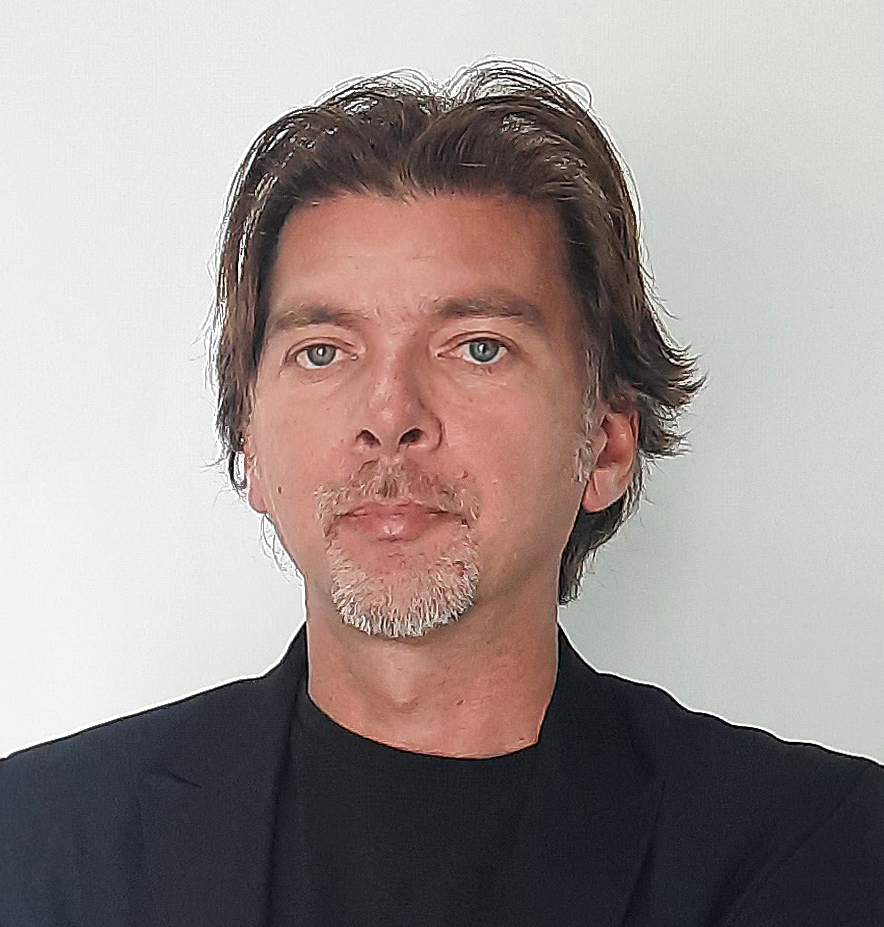
About the author
Milot Gusia works as a professor and editor, as well as a critic in the local and international art scene. He has worked on a number of programs in the field of art and culture.
He completed his master's studies in Graphic Design at the University of Pristina, as well as his MBA studies at Staffordshire University, Great Britain.

